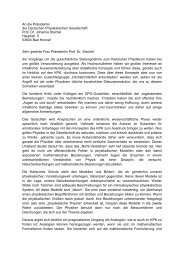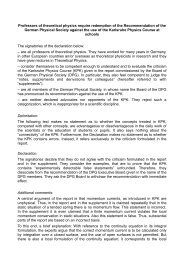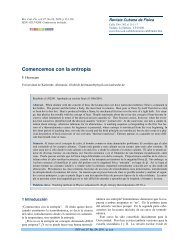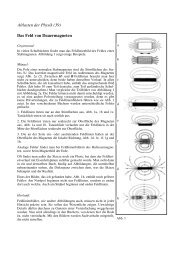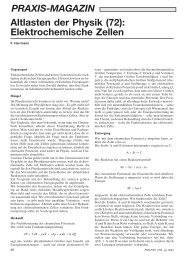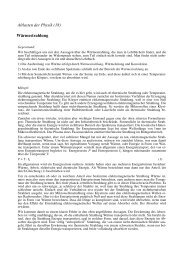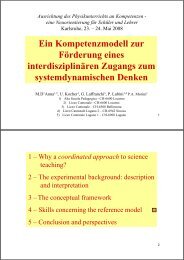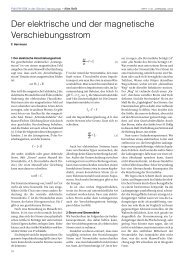122 Entropy as a measure of irreversibility
122 Entropy as a measure of irreversibility
122 Entropy as a measure of irreversibility
Create successful ePaper yourself
Turn your PDF publications into a flip-book with our unique Google optimized e-Paper software.
Historical burdens on physics<br />
<strong>122</strong> <strong>Entropy</strong> <strong>as</strong> a me<strong>as</strong>ure <strong>of</strong> <strong>irreversibility</strong><br />
Subject:<br />
Sometimes entropy is introduced <strong>as</strong> a me<strong>as</strong>ure <strong>of</strong> the <strong>irreversibility</strong> <strong>of</strong> a<br />
process. In this way it is possible to get a certain intuitive idea <strong>of</strong> the entropy<br />
which otherwise h<strong>as</strong> the reputation <strong>of</strong> being an abstract and obscure<br />
quantity.<br />
Deficiencies:<br />
1. When introducing entropy <strong>as</strong> a me<strong>as</strong>ure <strong>of</strong> <strong>irreversibility</strong>, the question<br />
gets e<strong>as</strong>ily out <strong>of</strong> sight what happens with the entropy after it h<strong>as</strong> been produced.<br />
A related question is what is the effect <strong>of</strong> that entropy whose origin<br />
we do not know. The entropy <strong>of</strong> the universe is constant in very good approximation.<br />
The entropy production which we observe in our immediate<br />
surroundings seems important to us but it is insignificant on a cosmic scale.<br />
Even on a terrestrial scale the produced entropy plays only a minor role in<br />
the total entropy balance. The entropy contained within the terrestrial globe<br />
is a about a million times that which is produced in a year at the Earth’s surface<br />
(essentially by the absorption <strong>of</strong> the sunlight). For whom knows entropy<br />
only <strong>as</strong> a me<strong>as</strong>ure <strong>of</strong> the <strong>irreversibility</strong> <strong>of</strong> a process this entropy does<br />
not mean much.<br />
2. We encounter entropy in the equation<br />
P = T · IS .! (1)<br />
The equation tells us that every entropy current is accompanied by an energy<br />
current. It h<strong>as</strong> the same structure <strong>as</strong> the familiar relation<br />
P = U · I .<br />
Equation (1) is useful for the description <strong>of</strong> heat engines. Their working<br />
principle is e<strong>as</strong>y to understand: <strong>Entropy</strong> is flowing through the engine; the<br />
entropy current at the inlet is equal to that at the outlet. Inside <strong>of</strong> the engine<br />
the entropy goes from high to low temperature thereby doing work, i.e. the<br />
engine emits energy by means <strong>of</strong> the output shaft. For the description <strong>of</strong> the<br />
working principle <strong>of</strong> the engine we need the entropy. Since the process is<br />
reversible the interpretation <strong>of</strong> entropy <strong>as</strong> a me<strong>as</strong>ure <strong>of</strong> <strong>irreversibility</strong> is <strong>of</strong><br />
little help.<br />
3. When looking for a me<strong>as</strong>ure <strong>of</strong> <strong>irreversibility</strong>, entropy is not really a good<br />
choice. Imagine we want to compare the <strong>irreversibility</strong> <strong>of</strong> processes going<br />
on in systems A and B. What we want to compare is not states but processes.<br />
Therefore, a statement about the entropy <strong>of</strong> A and B is not useful. It<br />
is better to consider the entropy production rate <strong>of</strong> A and B. However, if the<br />
production rate is greater in A than in B, we cannot conclude that process A<br />
is “more irreversible”. If system A is much larger than B, it can be that the<br />
process <strong>of</strong> B is “more irreversible”. Thus, in order to get a more convenient<br />
me<strong>as</strong>ure <strong>of</strong> <strong>irreversibility</strong> we should relate the entropy production rate to the<br />
size <strong>of</strong> the system. A better me<strong>as</strong>ures would be the molar entropy production<br />
rate.
Origin:<br />
The lack <strong>of</strong> an intuitive idea <strong>of</strong> the entropy that is stored in a system and the<br />
intention to add to the statistical interpretation a phenomenological interpretation.<br />
Disposal:<br />
When entropy is interpreted <strong>as</strong> the heat content (“heat” in the colloquial<br />
sense <strong>of</strong> the word) the molar entropy production rate is a trivial byproduct.<br />
Friedrich Herrmann, Karlsruhe Institute <strong>of</strong> Technology





